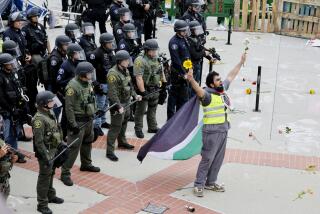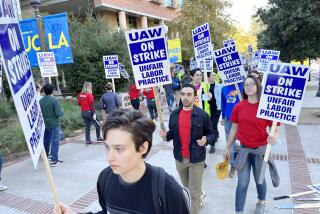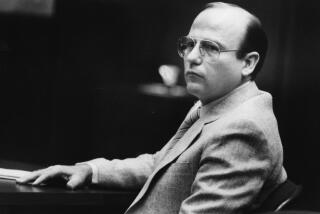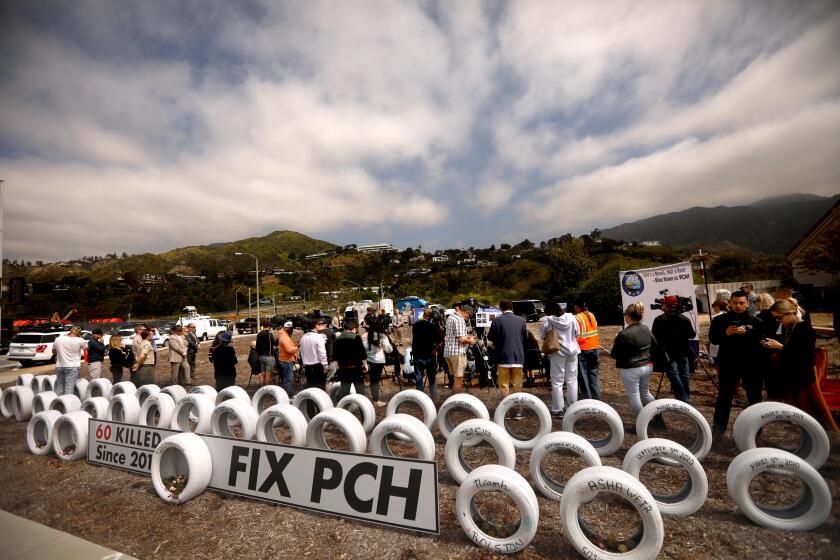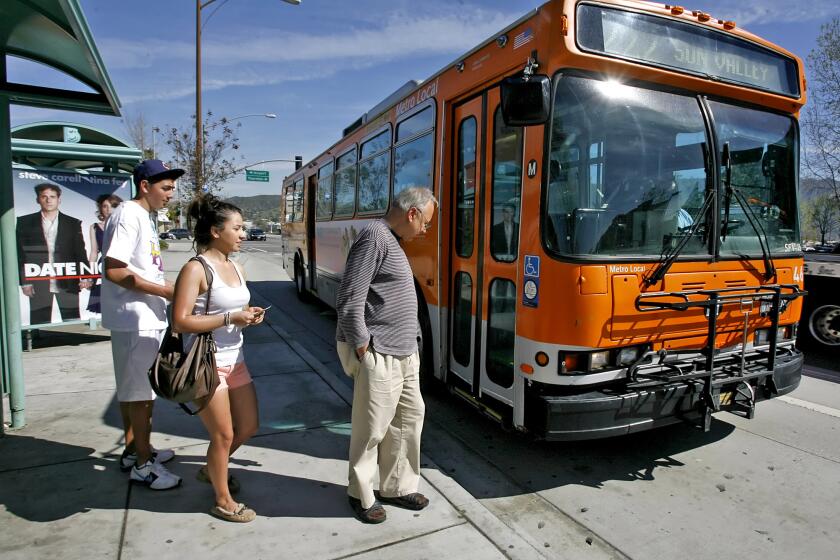Rise in Pedestrian Deaths Alarms San Franciscans
First a preschooler walking with her mother was killed by a red-light runner. Then a college student fell fatal victim to a late-night hit-and-run driver. Finally, a renowned kick-boxing champion was murdered earlier this month in a confrontation that followed another hit-and-run mishap.
This historically genteel walker’s paradise of scenic boulevards and hilly back streets -- where one-third of the residents don’t even own a car -- is assuming a more menacing edge as fatal encounters between motorists and pedestrians are rising at a rate that alarms officials.
Victims have been struck in crosswalks, at bus stops and while dashing into traffic. And even while walking on the sidewalk.
After hitting a high of 32 in 2000, the rate of pedestrians killed on the streets of San Francisco declined to 19 the following year and to 18 in 2002. A dozen people have been killed in the first six months of 2003, possibly signaling another ominous trend in the pedestrian death total.
San Francisco’s pedestrian fatality rate ranked third in the state, according to California Highway Patrol statistics for 2000, the last year for which such numbers are available. That year, Los Angeles had 99 pedestrian traffic deaths and San Diego had 34. But officials say San Francisco’s pedestrian population and compact size -- seven miles by seven miles -- create a crowded petri dish of traffic mishaps.
In the city’s financial district and along crowded Market Street, each day brings a dangerous dance among harried motorists, self-righteous pedestrians and militant bicyclists.
Now officials are erecting a roadblock to the behavior.
Several blocks from the spot where 22-year-old San Francisco State University student Srijaya Dalton was killed by a hit-and-run driver, Mayor Willie Brown announced a campaign urging drivers and walkers to be less aggressive and more civil to one another.
Called “Slow down, look around,” the program includes increased enforcement of laws against speeders and jaywalkers and will be plugged in television ads and bus and subway posters by former San Francisco 49ers running back Roger Craig.
“People drive too fast; they don’t drive defensively,” Brown said. “The theory we’re trying to convey is that motorists should assume that pedestrians are careless. If people drove full time that way, there wouldn’t be as many accidents.”
Critics say merely exacting a promise from motorists to slow down isn’t enough. As one reader wrote to a local newspaper’s editorial page: “Even in densely packed San Francisco, where a third of the residents don’t own cars, the [city] refuses to improve pedestrian safety if it means inconveniencing drivers.”
Traffic officials chafed at the claim, saying San Francisco is the first city in the nation to begin installing countdown crossing lights at all intersections. “This city is a national leader in pedestrian safety programs,” said Diana Hammons, a spokeswoman for the city’s Department of Parking and Traffic.
Police blame both sides for the mayhem. Of the dozen traffic deaths so far this year, pedestrians were at fault in four cases and drivers in seven, with one case undetermined. Said Lt. John Carlin of the San Francisco Police traffic division: “It’s aggressiveness on both sides.”
He said many hit-and-run drivers are either unlicensed or have been drinking, which gives them an incentive to flee the scene. “It’s a Catch-22,” he said. “While we’ve increased the consequences for driving drunk or with no license or insurance, there’s the greater risk of flight. And we have to deal with that.”
Experts say San Francisco’s walker-motorist showdown worsened when engineers in the 1950s built too many broad, one-way thoroughfares that are more like speedways than streets, marring a city famous for its footloose image.
“Advising motorists to ‘stop and look around’ is like telling Indy 500 drivers to watch out for someone on the track,” said James Corless, state director of the Surface Transportation Policy Project, an advocacy group that publishes a pedestrian safety report each year titled Mean Streets.
Supervisor Tom Ammiano formed a citizens task force that called for raised crosswalks and safety berms that lessen the length of the pedestrian crossings.
“We’re facing a combination of road rage, hit-and-run drivers and other traffic scofflaws that are endemic to any large city,” said Ammiano, who is a candidate for mayor. “But we’re talking life and death here. We can’t roll over and accommodate this problem as a big-city phenomenon. Our density and our car culture are a lethal combination and need to be addressed.”
In May, Dalton, the San Francisco State student, was killed by a hit-and-run driver as she crossed a busy six-lane thoroughfare in the city’s Sunset District. She was the fifth pedestrian since 2001 to have been struck and killed along a two-mile stretch of California Highway 1 south of Golden Gate Park, a busy artery connecting the Golden Gate Bridge with Interstate 280.
The film major, who spoke fluent Italian, was hit after she left a graduation party. The university has offered a $10,000 reward for information leading to the arrest of her killer, who remains at large.
The most recent death involved a driver unlisted in any statistical survey: a parolee who refused to go back to prison.
Rodger Wayne Chastain shot and killed a popular kick-boxer after Chastain had sideswiped the athlete’s parked car and fled the scene. The incident occurred Aug. 1 outside the studio run by 32-year-old Alex Gong.
While giving a lesson, Gong saw his Jeep struck on the street outside. He gave chase, barefoot and wearing his boxing gloves, police say. He accosted Chastain as he waited at a nearby intersection. During the face-off, Chastain shot Gong at point-blank range and sped off, leaving his body sprawled on the pavement.
Days later, Chastain, 22, who had a record for stealing cars and possessing guns, fatally shot himself after being surrounded by police at a Bay Area motel.
The city’s 2003 string of pedestrian fatalities began in February when 4-year-old Elizabeth Dominguez was killed when she was hit by an out-of-control city truck as she walked home from preschool with her mother.
Police say Sebastian Garcia ran a red light in the city’s Mission District. He lost control, striking a car and then plowing into a group of pedestrians including Dominguez and her mother. The girl, who dreamed of becoming a ballerina in a circus and was one month shy of her 5th birthday, was pinned against the wall of a pizzeria.
“Imagine being a mother walking your child home from school and some guy flies over the curb, crushing your child against a pizza parlor while you stand there in shock holding your other daughter,” said the family’s Santa Monica-based attorney, Brian Panish.
The dead girl’s family has filed a $25-million lawsuit against the city. The truck driver has yet to be charged, angering Panish, who said officials must hold all culpable drivers responsible, city employees included.
In light of the girl’s death, workers have installed cameras to catch red-light runners at the intersection.
Meanwhile, San Francisco officials say they hope the skein of deaths will not damage the city’s reputation as a pedestrian-friendly paradise.
“If the problem persists, people could certainly reach the conclusion that this is not a safe place to walk,” Ammiano said. “We just don’t want it to get to that level.”
More to Read
Start your day right
Sign up for Essential California for news, features and recommendations from the L.A. Times and beyond in your inbox six days a week.
You may occasionally receive promotional content from the Los Angeles Times.
